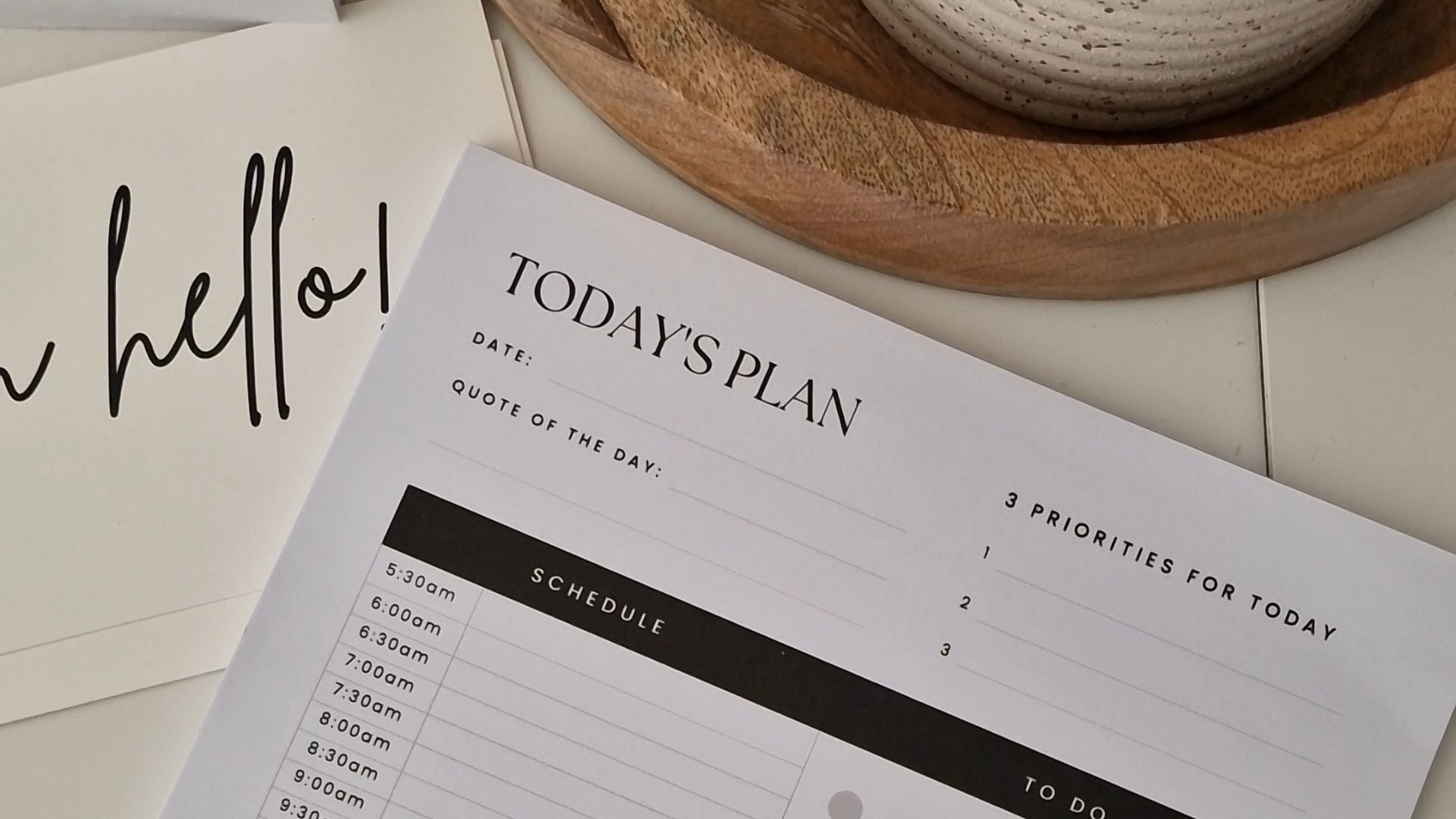
The Ultimate Guide to Monthly, Weekly and Daily Planning: Stay Organised Without the Overwhelm
Feeling overwhelmed by never-ending to-do lists or constantly busy but never truly productive? Intentional planning could be your game-changer. Intentional planning means choosing how you spend your time with purpose, not pressure. It's about aligning your schedule with your values, rather than just reacting to whatever demands your attention.
This guide walks you through how to use monthly, weekly, and daily planning together to help you stay organised, feel in control, and actually move forward on what matters most, without burning out.
Whether you're juggling work, personal goals, or simply trying to find a better rhythm to your day, learning to plan with purpose can create real clarity and avoids decision fatigue. By developing a monthly overview, creating weekly focus, and setting up daily habits, you can stay on top of your priorities without running yourself ragged.
Start with monthly planning: your big-picture view
Monthly planning helps you take a step back and look at the bigger picture. It’s where you set your overarching goals, deadlines, and important dates. Rather than reacting to what comes up day by day, you give yourself a clear sense of direction for the weeks ahead.
When you plan monthly, you:
- Create clarity around your focus for the month
- Map out any key dates, launches, or deadlines
- Break your goals down into manageable weekly priorities
- Avoid the pressure of last-minute tasks by working proactively
Monthly planning is especially powerful when you have big personal or professional goals. Want to launch a project, start a new habit, or hit a milestone in your business? Start by looking at your month and asking: "What do I want to be true by the end of this month?"
Monthly planning steps:
Review the previous month: Reflect on what went well, what felt challenging, and any progress made. Jot down key takeaways.
Set 1–3 key goals or focus areas: Don’t overcommit, choose what matters most.
Add important dates to your calendar: These might include appointments, social plans, deadlines, or personal events.
Roughly map out your month: Break your goals into chunks and assign them to different weeks. This helps avoid cramming everything in at once.
Monthly planning tips:
Use a dedicated monthly spread in your planner or wall calendar
Add sticky notes, or colour code categories (work, home, personal)
Keep it visible so you can stay focused on your direction
Include space to track recurring commitments like bills, birthdays, or seasonal goals
Move into weekly planning: your bridge between goals and daily action
Weekly planning is the key to making real progress on your goals. It acts as the bridge between high-level intentions and the smaller steps you take every day. Without weekly planning, it's easy to spend your time putting out fires or getting distracted by lower-priority tasks.
When you plan weekly, you:
Make space for big-picture thinking
Align your tasks with your long-term goals
Reduce decision fatigue throughout the week
Create a more balanced and realistic schedule
A simple weekly planning routine:
Reflect on the past week: What worked? What didn’t? What felt energising or draining?
Review your monthly goals: What specific progress can you make this week?
Identify 3–5 key priorities: These could be work tasks, personal goals, errands, or habits.
Theme your days: Try assigning themes to each day (e.g. Content Monday, Admin Tuesday). This helps reduce context switching.
Break down your goals into action steps: Spread these tasks across the week in a realistic way.
Leave buffer time: Life will throw curveballs. Plan for it by keeping some buffer time and accepting that you might need to be flexible.
Weekly planning tips:
Set aside 20–30 minutes for planning at the end of the working week or each Sunday evening
Use a weekly planner pad or layout to see everything at a glance
Include space for your top 3 priorities, habits, and space for notes or reflections
Try a weekly review prompt like "What do I want to feel by Friday?" to check in with your mindset

Finish with daily planning: small steps, big results
Daily planning keeps you grounded. It gives you a moment to reset your focus and be intentional about how you want to use your time. It’s less about cramming in everything and more about doing the right things, calmly, clearly and productively.
How to plan your day effectively:
Start with 1–3 key tasks: Focus on what will make the biggest difference today.
Add your commitments: Include meetings, appointments, or errands.
Time-block or batch tasks: If helpful, assign time windows to work on specific types of tasks.
Plan breaks: Add breathing room for coffee, lunch, and screen-free time.
End with reflection: What did you accomplish? What will you carry forward?
If you struggle with daily productivity, try using a planner that prompts you to set intentions and reflect. That extra five minutes of planning can change the course of your day.
Daily planning tips:
Keep your list short and focused
Prioritise tasks that align with your weekly goals. Our Daily planner pad helps you get really focused.
- Prioritise tasks that align with your weekly goals
- Don’t forget to include self-care or rest
- End your day with a small ritual, like a gratitude note or highlight of the day
How to stay consistent with planning
Sticking to your planning habits is where many people struggle. The trick is to make your planning time enjoyable and part of your routine, rather than another task to check off.
Here’s how to make it stick:
Schedule your planning time: Add it to your calendar like any other important meeting.
Pair it with a habit: Plan your week over Sunday coffee or reflect daily during your wind-down routine.
Use tools you love: Choose stationery that feels beautiful and enjoyable to use. It makes all the difference.
Start small: If a full planning session feels too much, begin with just a 5-minute check-in.
Celebrate your progress: At the end of each week or month, take a moment to appreciate how far you’ve come.
Consistency doesn’t mean perfection. It’s about showing up, adjusting as you go, and creating a rhythm that supports you.
Common planning mistakes to avoid
Even with the best intentions, it’s easy to fall into some planning traps. Here’s what to watch out for:
Overloading your schedule: You’re not a robot. Be honest about how much time things really take.
Skipping reviews: Reflection helps you learn and adjust. Don’t skip your weekly or monthly review.
Planning without flexibility: Life happens. Leave wiggle room so you don’t spiral when things change.
Ignoring energy levels: Plan your most important work during your most focused time of day.
Tools and planners to support your planning routine
You don’t need a complicated system to make planning work - the key is to use tools that suit your lifestyle and help you stay consistent. We recommend having:
A monthly view to see big dates and long-term goals
A weekly layout to prioritise your week at a glance
A daily planner or section to break things down into actionable steps
A gratitude journal to help you focus and reset at the start and end of the day
Whether you use printable planning sheets, a ring binder organiser, or a dedicated planning pad, having everything in one place makes it easier to stay on track.
P.S. Coming soon from Papers & Gems: a customisable planner system designed to support your monthly, weekly, and daily planning flow. It’s built for calm productivity, to help you set mindful goals, break them into simple steps, and stay aligned each day. With a luxe vegan leather binder and inserts designed for clarity, this is planning you’ll actually look forward to. Join our email list to be the first to hear about it!
Final thoughts
Planning isn’t about cramming more into your schedule. It’s about using your time intentionally so you can do less, better. Whether you're working on a big project, building a habit, or simply trying to feel more in control, monthly, weekly, and daily planning gives you the structure to succeed without the stress.
Start small. You don’t have to do it all at once. Begin with a Sunday planning session or a quick daily check-in. As your routine builds, you’ll find more clarity, more calm, and more time for what matters.
And if you're looking for a planner that brings it all together? Keep an eye out for our upcoming product launches. They’re always thoughtfully designed to help you live intentionally, every single day.
Ready to plan your week with intention?
Get blog post updates delivered straight to your inbox - join our email newsletter.


